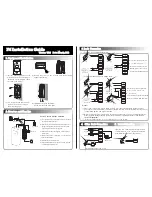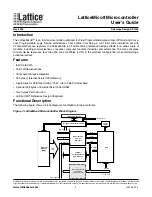
Reset Status and Override Control
274
SLAU356I – March 2015 – Revised June 2019
Copyright © 2015–2019, Texas Instruments Incorporated
System Controller (SYSCTL)
4.7
Reset Status and Override Control
The SYSCTL module has registers to monitor the status of the various classes of resets in the device. In
addition, it can override device resets and initiate reset requests for debug purposes. See
for
details.
NOTE:
Reset overrides are for debug of application code and take effect only when the device
security (JTAG and SWD lock or IP protection) is inactive.
4.8
Device Security
This section talks about the device security control options and how to setup device security within the
MSP432P4xx device family.
4.8.1 Device Security Introduction
One of the most important functions of the SYSCTL module is the security control of the device. The
SYSCTL enables the capability to secure the device against accesses from the debugger (JTAG and
SWD lock feature). In addition, the SYSCTL enables security control for different configurable zones of the
device (IP protection feature). The application can load a secure piece of code (IP software/middleware)
into the device flash memory and configure that zone of memory as secure. This section deals with how
the application can set up the device for the various device security options.
4.8.2 Device Security Components
The SYSCTL module achieves device security by interacting with the following components on the device.
•
Device boot-code
•
Flash/JTAG mailbox mechanism for application level interaction with device boot-code
4.8.3 JTAG and SWD Lock Based Security
The SYSCTL module provides provisions to block the debugger accesses to the device through the JTAG
or SWD interfaces. This feature is called JTAG and SWD lock. To setup JTAG and SWD lock, application
is required to initiate a boot override sequence in the system. See
for details on boot
overrides. Post a successful boot override sequence, only a few registers of SYSCTL are accessible
through the JTAG and SWD interface. All other debug accesses are blocked through these interfaces.
Access into a JTAG and SWD locked device can be re-enabled through initiation of a factory reset boot
override request through the SYSCTL registers and Flash boot-override mailbox.
4.8.4 IP Protection Through Secure Memory Zones
If IP protection is deployed, sections of the Bank 0 of flash main memory can be configured as 'secure
zones'. These zones can help single or multiple vendors to achieve a higher level of protection to store
sensitive or proprietary data. IP protection helps protecting some flash regions while a third-party user can
develop code and debug it in another part of the flash. An IP protected region provides a higher level of
protection against running code outside of that region and against a user accessing the device through
debug. Any access to an IP protected secure memory zone is filtered based on the following criteria:
•
Instruction Fetches to an IP protected secure zone are always permitted
•
Data fetches from the secure zone are permitted only if both of the following conditions are satisfied
–
Instruction causing the data fetch lies within the same secure zone
–
The secure zone being accessed has been unlocked for data accesses. This is a configurable
feature, and is described in more detail in
•
Any data access that violates this requirement is considered unauthorized and returns an error
response.
•
All debugger (JTAG or SWD) or bootloader (BSL) accesses to secure memory zones are treated as
unauthorized and also return an error response.
















































